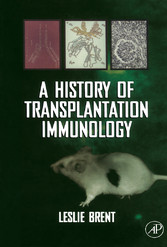Suchen und Finden
Front Cover
1
A History of Transplantation Immunology
4
Copyright Page
5
Contents
6
Preface
12
Foreword
16
Dedication
19
Acknowledgements
20
A Note on Nomenclature
22
Chapter 1. Landmarks in Immunology
24
The Great Early Pioneers
25
The Discovery of Blood Group Antigens
31
P.B. Medawar and the Immunologic Basis of Allograft Rejection
31
Tolerance and Autoimmunity
31
The Development of Cellular Immunology
34
Concurrent Developments on the Antibody Front
46
Theories of Antibody Formation
48
Some Other Important Developments
53
References
69
Biographies
76
Chapter 2. The Immunologic Basis of Allograft Rejection
79
The Early Years
79
Rejection Mechanisms
97
The Chemical Nature of Alloantingens
111
Immunogenicity, the concept of the Passenger Leukocyte, and Antigen Presentation
114
Immunologically Privileged Sites
123
Are Invertebrates Capable of Allograft Reactivity?
127
References
130
Biographies
139
Chapter 3. Blood Transfusion, Blood Groups and Hemolytic Disease of the Newborn
142
Blood Transfusion Before the Birth of Immunology
142
Karl Landsteiner's Vital Discoveries
143
Graft-Versus-Host Reactions After Blood Transfusions
145
The Discovery of the Rh System and Hemolytic Disease of the Newborn
146
Prevention of Hemolytic Disease of the Newborn
149
References
152
Chapter 4. Immunogenetics: Histocompatibility Antigens – Structure and Function
154
The Seminal Influence of Gorer and Snell
154
H-2: its complexity unravelled
156
The Two Locus Model of H-2: Controversy and Resolution
159
The Early History of HLA
161
Further Development of the HLA System
163
Chemical Structure: Enter the Biochemists and Molecular Biologists
170
The Function of Histocompatibility Antigens
174
The "Minor" Histocompatibility Antigens: Minor but Important?
185
An Apology and a Comment
191
References
192
Biographies
199
Chapter 5. Fetally and Neonatally Induced Immunologic Tolerance
205
Evidence from Embryology
205
The Cattle Story. Vital Landmarks and the Concept of Self/Non-Self
207
Experimental Verification of the Tolerance Concept
211
Mechanisms of Tolerance
230
Allogenic Tolerance and Self-tolerance
239
Is Tolerance Inherited?
240
Conclusions
241
Addendum
242
References
242
Biographies
249
Chapter 6. Immunoregulation: The Search for the Holy Grail
253
The Phenomenon of Immunologic Enhancement
254
Enter Microvascular Surgery and the Rat Kidney Allograft
260
Enhancement/Tolerance of Rat Kidneys
262
Anti-Lymphocyte Serum (ALS)
270
The Introduction of Monoclonal Antibody Technology:
288
Suppressor Cells
294
Other Interesting Models for the Induction of Tolerance
304
Conclusion
314
References
315
Biographies
327
Chapter 7. Clinical Aspects and Immunosuppression
329
The Dawn of "Modern" Kidney Allotransplantation
329
The Advent of Immunosuppressive Drugs
333
A Note on the Evolution of Cardiac and Liver Transplantation
345
The Blood Transfusion Effect
346
Chimerism and Tolerance
352
References
356
Biographies
361
Chapter 8. Graft-versus-Host Disease and Bone Marrow Transplantation
367
Secondary (or Homologous) Disease in Lethally Irradiated Mice
367
The Discovery of Graft-Versus-Host Disease (GVHD)
370
The Nature of the Anti-Host Response
377
Some Clinical Aspects of Bone Marrow Transplantation
382
Concluding Comments
390
References
390
Biographies
395
Chapter 9. Xenotransplantation
400
An Ancient Dream of the Pioneer Surgeons
401
The Middle Era: the Dream Revived
406
The Modern Era
410
Conclusion
420
References
421
Biographies
424
Chapter 10. The Mammalian Fetus: Nature's (Almost) Perfect Allograft
426
Does the Fetus Lack Antigens?
428
Is the Placenta a Cell-impermeable Barrier?
429
Does Fetal Trophoblast Lack Paternal Antigens, or are they Masked?
431
The Uterus as an Immunologically Privileged Site
434
Physiologic and Immunologic Changes in the Pregnant Female
435
Specific Immunoregulation
436
Tolerance in Pregnancy?
438
Recurrent Spontaneous Abortions: do they have an Immunologic Cause?
439
Conclusion
441
References
442
Chapter 11. The Interaction between Immunology and Transplant Surgery (and Other Matters)
445
The Contribution of Transplantation Immunology to Basic Immunology
447
The Impact of the Surgeons
448
The Contribution of Transplantation Immunology to Clinical Transplantation
448
Other Matters
450
References
450
Subject Index
452
Author Index
458
Alle Preise verstehen sich inklusive der gesetzlichen MwSt.











